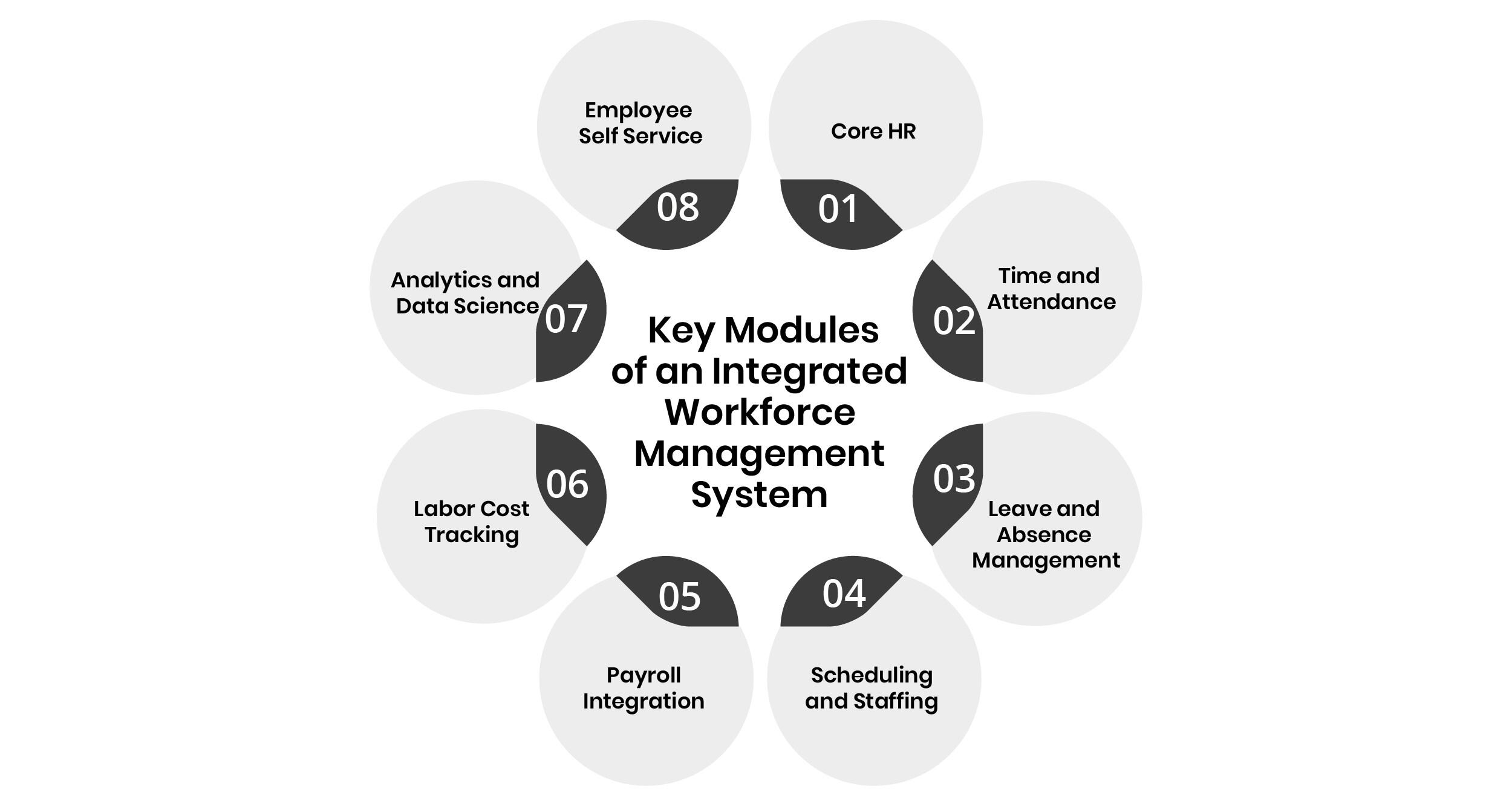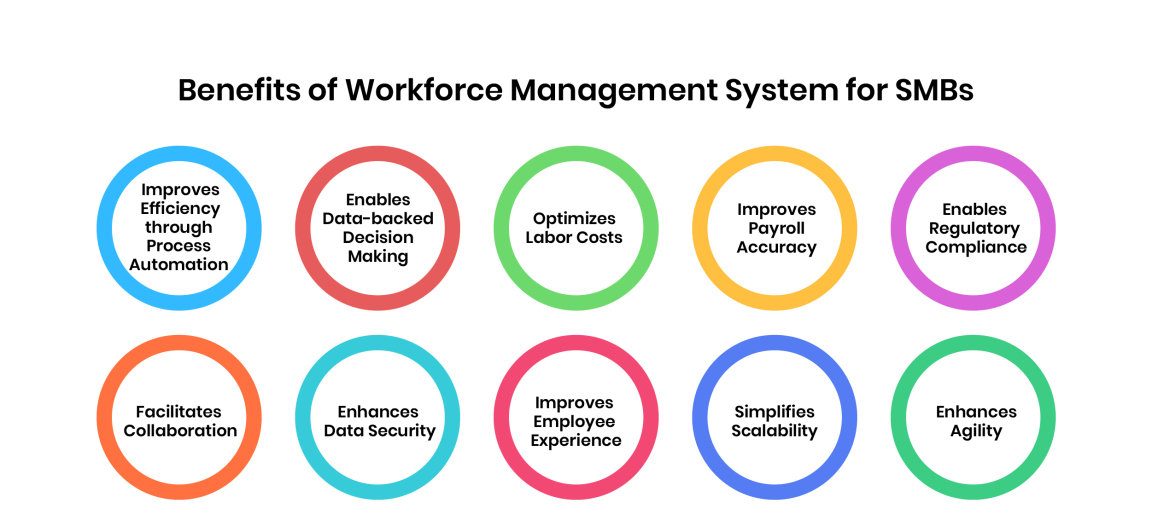An optimized workforce is the key driver behind the success of any business, regardless of its size. However, managing people can prove to be quite challenging, especially when done manually. This is where an integrated system for workforce management can make all the difference.
An integrated workforce management system refers to a human capital management (HCM) software that brings various HR functions under one umbrella. This includes functions such as time tracking, scheduling, leave and absence management, payroll processing, labor cost tracking, and more. The system consolidates all the employee data at a central location and automates most of the tasks, minimizing the need for manual work.
For medium, small, and micro-businesses struggling with spreadsheet-based processes, an integrated workforce management system is nothing short of a boon. It saves crucial man-hours, eliminates the risk of errors, optimizes productivity, and provides data-backed insights to make informed decisions.
Here is a closer look at what an integrated workforce management system is, its key features, and how medium, small, and micro enterprises can benefit from it.
An integrated workforce management system refers to a unified human capital management (HCM) platform that helps organizations efficiently manage their entire workforce. It consolidates all aspects of managing people onto a single technology solution, rather than having disconnected processes and tools.
In simpler terms, an integrated system takes care of an organization’s complete employee lifecycle on one centralized system. This includes essential workforce management functions like time tracking, scheduling, leave management, payroll processing, analytics, and more.
By bringing these functions together instead of separate software solutions, it delivers the following advantages:
In essence, it is an organization’s centralized workforce command center that effectively manages the end-to-end employment experience. By bringing all these functionalities under one platform, integrated workforce management in business eliminates the need for multiple disparate tools. It acts as a central workforce data repository that enables organizations to have end-to-end visibility and make data-backed decisions across the employee lifecycle.
An integrated workforce system comprises the following key modules: 
The Core HR module serves as the foundation that maintains and manages all employee records in the system, including:
This module automates time-tracking processes across the organization based on policies, such as:
The leave management functionality handles applying for time off and tracking absenteeism:
This module focuses on optimal labor utilization through schedules and budgets:
Seamlessly moves employee hours data to payroll for processing salaries:
Provides real-time visibility into gross margins through labor metrics:
Inbuilt reports and analytics into providing workforce insights for planning:
Gives employees ownership of their work life like applying for leave, checking schedules, etc.:
Taken together, these modules provide a comprehensive system to manage the complete workforce lifecycle. The integrated nature delivers superior efficiency, analytics, and experience over disparate tools.
Here are some noteworthy advantages that medium, small, and micro businesses can realize by implementing an integrated workforce management system:

For SMBs (Small and Medium-sized Businesses), much of the workforce management process is still manual and spreadsheet-based, which is error-prone and consumes unnecessary hours. An integrated system automates mundane administrative tasks like leave approval workflows, overtime calculations, schedule generation, etc., based on configurable rules. This results in improved efficiency and accelerated processes.
Since an integrated system centralizes workforce data, it becomes easier for SMBs to slice and dice it. Built-in analytics provide real-time visibility into metrics like time tracking compliance, absenteeism, turnover, etc. This data can assist SMBs immensely in making appropriate decisions regarding recruitment, engagement initiatives, training needs, etc.
Managing labor to control operational costs is crucial, especially for smaller businesses. An integrated workforce management system provides real-time visibility into labor data, allowing SMBs to optimize staffing levels. Features like schedule optimization further help to contain unnecessary overtime and idle time.
For SMBs processing payroll manually, errors could lead to workplace trust issues. When integrated with time tracking software, the payroll happens automatically based on hours logged, minimizing discrepancies. This saves money and also helps maintain a healthy work environment.
With ever-evolving employment laws, compliance can be challenging for resource-constrained SMBs without automated tools. An integrated system stays updated with the policies and accurately tracks essential metrics like hours worked, leave accruals, etc. This reduces the risk of non-compliance penalties due to inaccurate paperwork.
An integrated workforce management system acts as a single source of truth, ensuring optimal collaboration between employees, managers, and HR. It eliminates delays due to back-and-forth communication for things like leave requests, overtime approvals, etc., through configurable workflows.
Enhances Data Security
For SMBs, an integrated system eliminates the tedious task of managing data across different spreadsheets and paper documents. It maintains employee information in a centralized, secure database with role-based access control. This enhances data security while facilitating controlled information access.
Tedious administrative tasks like updating personal information or applying for leave often lead to poor experience for employees. Self-service options in an integrated workforce management system empower them to manage their work-life without relying on HR. This boosts convenience, engagement, and satisfaction levels.
As SMBs grow and onboard more employees across locations, an integrated system can scale up seamlessly. It can effectively handle increased data and processes without needing fresh investments in infrastructure. The unified interface ensures that scaling up does not impact ease of use.
The out-of-the-box integration capabilities in an integrated workforce management system allow it to sync with existing SMB software like payroll, CRM, etc. This makes it agile for SMBs to leverage the functionalities without disrupting legacy systems or undergoing complex IT implementations.
The workforce is the most prized asset for any business, irrespective of its size or scale. An integrated, automated system for managing people empowers SMBs to unlock greater value from their human capital through optimized processes, informed decisions, and elevated efficiency.
This website uses cookies to enhance website functionalities and improve your online experience. By browsing this website, you agree to the use of cookies as outlined in our privacy policy .